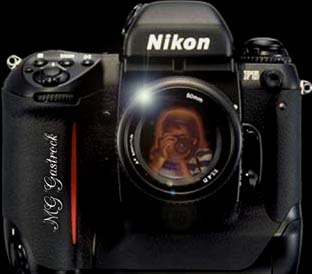The Nikon F5 is the current flagship of the venerable F
line and brings major technological advances in many, if not
all, 35mm SLR feature categories.
Key features include:
- Nikon F Lens Mount;
- 8 frames per second film advance with focus tracking;
can shoot an entire 36-exposure roll in 4 seconds.
- RGB Color Matrix Meter that evaluates brightness,
contrast and color(a first);
- 1,005-Pixel exposure sensors (each taking an
idividual light reading) placed evenly throughout the
picture frame. Readings are evaluated based on
neuro-net intelligence technology;
- On-Board memory storage with 30,000 photo scenes that
are compared to current scene for optimal exposure;
- Infinitely variable center-weighted metering; can be
manually adjusted for center weighted metering from
1mm to entire frame.
- Multi-Cam 1300 AF Sensor with Wide-Area Cross-Type
Array with 4 AF sensors placed in a circle around the
center sensor to capture off-center subjects; Will
follow focus as subject moves across the frame;
- 24 custom settings, many with multiple options;
- Photo Manager Software adds more custom settings via
Mac or PC.
- A self-diagnostic shutter that will monitor and
adjust itself during use;
- Flash meter reads color, and independently relative
flash and ambient light levels independently;
- 1/300 second TTL flash sync;
- Titanium meter housing, die-cast chassis; all-metal
outer shell.
- New interchangeable viewfinders and screens;
- Multi-Control back expands functions, offers
alpha-numeric imprinting between frames;
- Battery capacity up to 200 rolls of 36 exposure
during ideal conditions, depending on type of battery
used.

Comments
Nikon strongly supports traditional silver-based
photography. While it is reasonable to expect that eventually
Nikon will offer some form of a digital back for the F5, it
is reassuring to know that this isn't considered a high
priority.
Instead, Nikon built a camera from scratch, incorporating
new technologies where they made sense and will make the
user's life easier. The exposure system is impressive: the
first that's sensitive to color as well as contrast and
brightness, it recognizes that photographers adjust exposure
if there is a strong predominant color. Blue is often
underexposed slightly for more saturation, for instance.
I half-jokingly asked a Nikon spokesperson if there is a
Black-and-White Override for this feature (after all, this is
Black and White World). The serious response was that color
sensitive metering will also help black and white
photographers. While it may not affect exposure in most
cases, it will recognize when, for instance, a dark red
filter is used, and compensate accordingly.
Some of the numbers involved with the F5 boggle the mind.
1005 exposure segment metering with each segment taking its
own reading is instantly measured against the 30,000 images
stored in the camera's on-board database to help the camera's
neurologic net determine the best exposure for that
particular situation. This can be finely tuned with the
infinitely adjustable center-weighted metering (from 1mm to
the entire image). And it all happens in the background.
Focusing is fast and very smart. An array of five focus
sensors--one in the center, four in a circle surrounding
it--covers more off-center subjects than other models, and
should be a welcome feature. Focus lock maintaints focus on a
subject that moves from one part of the frame to the other
without forcing the photographer to center focus and
re-compose, as in other AF models.
The F mount was a no-brainer: Nikon knew insisting on
backwards compatability would make their engineers' jobs more
difficult, "but for many reasons, well worth the
effort," according to Richard LoPinto. A little dig at
Canon here?
There is only one complaint about the F5: it's heavy. Due
to its no-compromise all-metal body and Titanium meter
housing construction, the camera weighs in at a hefty 3
pounds! But the camera is solid. The AF is fast and decisive.
The shutter lag time is the fastest I've seen on a non-manual
camera, and the 8 fps operation is incredibly fast but with
very little vibration, thanks to a new mirror movement
mechanism and a smooth, quiet motor drive.
Professional photographers will most likely recognize the
usefulness of the F5 and embrace it, as will well-heeled
serious hobbyists. Nikon says they wanted to create a camera
that would make the technique of picture-taking less
distracting to the art of capturing the decisive moment. With
the F5, they have taken a giant step in this direction.
- MacArthur Gastrock 1999 -
